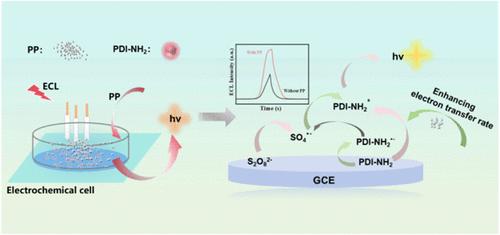一种电化学发光激活的两亲性苝二亚胺探针:在环境中实现聚丙烯纳米塑料的高灵敏度和选择性检测
IF 6.7
1区 化学
Q1 CHEMISTRY, ANALYTICAL
引用次数: 0
摘要
纳米塑料污染已成为环境和人类健康领域的一个重要问题。然而,开发高灵敏度的方法来快速识别和检测复杂系统中低浓度的纳米塑料仍然是一个相当大的挑战。本研究利用两亲性苝二酰亚胺(PDI-NH2)作为探针,结合电化学发光(ECL)技术对聚丙烯(PP)纳米塑料进行了灵敏检测。PDI-NH2探针对水溶液中PP的ECL信号有显著增强,呈浓度依赖性响应。从而实现了对水溶液中PP的超灵敏特异检测,检出限低至0.948 mg·L-1。一系列综合实验表明PDI-NH2通过静电和疏水相互作用与PP结合。此外,等温滴定量热法和密度泛函理论(DFT)计算进一步证实了ECL信号的增强可归因于PDI-NH2与纳米塑料之间强烈而显著的亲和力。这种强亲和力导致电子转移速率显著提高。此外,值得注意的是,ECL探针在检测实际样品中的PP方面证明了其有效性,为其在各种环境和工业环境中监测和评估纳米塑料污染开辟了可能性。本文章由计算机程序翻译,如有差异,请以英文原文为准。

An Electrochemiluminescence-Activated Amphiphilic Perylene Diimide Probe: Enabling Highly Sensitive and Selective Detection of Polypropylene Nanoplastics in the Environment
Nanoplastic pollution has emerged as a significant issue in both the environmental and human health fields. However, developing highly sensitive approaches to promptly identify and detect low concentrations of nanoplastics within complex systems remains a considerable challenge. Here, we utilized the amphiphilic perylene diimide (PDI-NH2) as a probe in combination with electrochemiluminescence (ECL) for the sensitive detection of polypropylene (PP) nanoplastics. The PDI-NH2 probe shows a remarkable enhancement of the ECL signal on PP in aqueous solutions, presenting a concentration-dependent response. This enables the ultrasensitive and specific detection of PP in aqueous solutions with a detection limit as low as 0.948 mg·L–1. A series of comprehensive experiments indicate that PDI-NH2 binds to PP through electrostatic and hydrophobic interactions. Moreover, isothermal titration calorimetry and density functional theory (DFT) calculations further confirm that the enhancement of the ECL signal can be attributed to the strong and significant affinity between PDI-NH2 and nanoplastics. This strong affinity leads to a significantly high electron transfer rate. Additionally, it is notable that the ECL probe proved its effectiveness in detecting PP in actual samples, opening up possibilities for its application in monitoring and assessing nanoplastics pollution in various environmental and industrial settings.
求助全文
通过发布文献求助,成功后即可免费获取论文全文。
去求助
来源期刊

Analytical Chemistry
化学-分析化学
CiteScore
12.10
自引率
12.20%
发文量
1949
审稿时长
1.4 months
期刊介绍:
Analytical Chemistry, a peer-reviewed research journal, focuses on disseminating new and original knowledge across all branches of analytical chemistry. Fundamental articles may explore general principles of chemical measurement science and need not directly address existing or potential analytical methodology. They can be entirely theoretical or report experimental results. Contributions may cover various phases of analytical operations, including sampling, bioanalysis, electrochemistry, mass spectrometry, microscale and nanoscale systems, environmental analysis, separations, spectroscopy, chemical reactions and selectivity, instrumentation, imaging, surface analysis, and data processing. Papers discussing known analytical methods should present a significant, original application of the method, a notable improvement, or results on an important analyte.
 求助内容:
求助内容: 应助结果提醒方式:
应助结果提醒方式:


